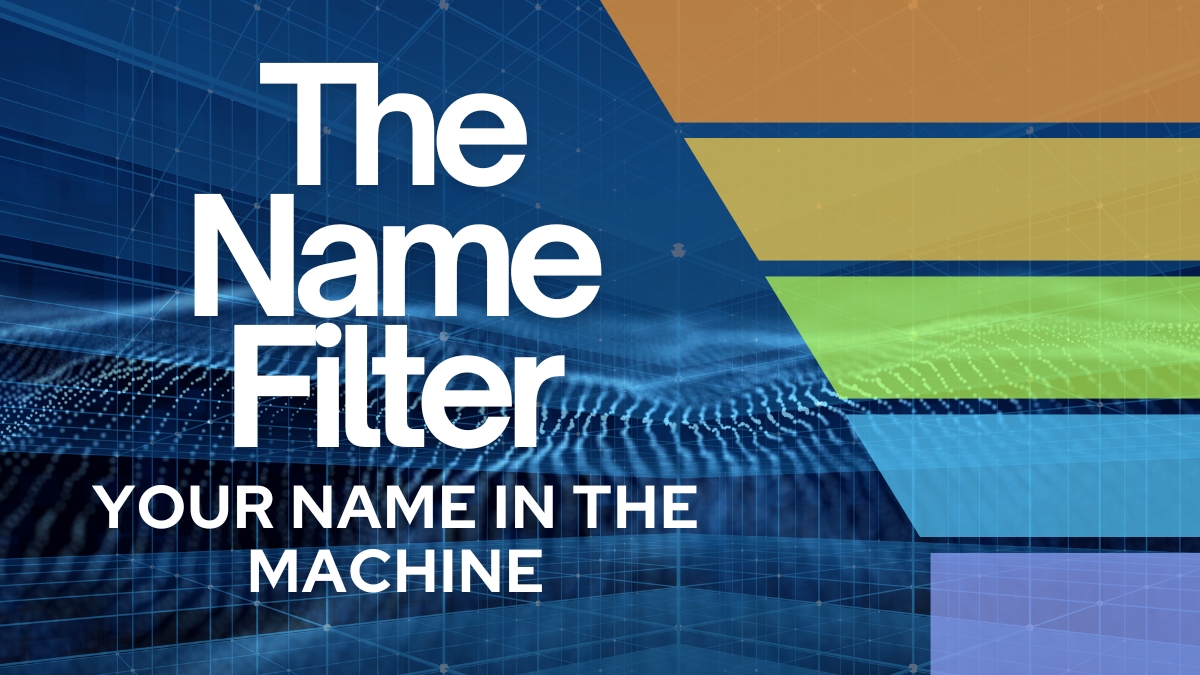Why Your Name Determines What Jobs, Ads, or Messages Algorithms Show You Online
You once had a personal name. It served for your culture, your family, and possibly even your generation. It now also stands for data. You’re doing more than simply identifying yourself each time you fill out a form, submit a resume, or make a profile. A machine is learning how to think about you from you.
Names serve as hints for algorithms. In order to predict who you are, they relate your name to language, geography, and patterns of behavior. As a result, even something as basic as a name can influence what you see online, including advertisements, job postings, and social media connections.
The internet is no longer one shared space. It’s a collection of tailored experiences, each shaped by invisible filters. And one of the strongest filters, though rarely discussed, is the one tied to your name.
How Algorithms See Names
When a person sees your name, they may consider its sound or meaning. A machine has an unique view on things. Your name is treated as a piece of data.
Algorithms look for patterns in massive datasets. They search for statistical similarities when they see your name. A name may be classified as Hispanic if it is commonly used in Spanish-speaking nations. A name that might be classified as Western based on patterns in English-speaking areas. The system then modifies what it hides and what it shows to you.
Almost all online spaces use this type of name-based sorting. It is used by social media networks to customize suggestions. It is used by job sites to rate applicants. It is used by marketers to target offerings. There is no malice behind any of this. It’s just the way automated systems pick things up.
But while machines don’t mean harm, the patterns they replicate often reflect the same social divides people have struggled with for decades.
The Job Market’s Digital Divide
Bias in hiring by name is not new. It appeared in cover letters and resumes before to algorithms. Even when their qualifications were the same, applicants with conventionally white-sounding names were much more likely to be called back than those with African, Asian, or Middle Eastern names, according to studies conducted as early as the 2000s.
When AI Learns Old Habits
On paper, technology should already resolve that. By using statistics to guide the process, automated recruiting was intended to lessen human bias. Rather, it covertly digitalized the same biases.
One study from 2021 involved sending similar resumes under different names to major job portals. None of the recruiters intentionally chose to provide identical candidates with names like “Greg” or “Emily” with between 30 and 40 percent more interview invitations than those with names like “Jamal” or “Lakisha’”. All the filtering algorithms had to do was learn from years of past hiring information.
AI-powered employment platforms examine resumes and compare them to previously successful profiles. The system learns to favor the same characteristics if a company has traditionally recruited more people with particular names, educational backgrounds, or geographic locations. As a result, the same kind of people keep coming up, creating a feedback loop.
The Invisible Hand in Job Ads
Bias can begin even before an application is filed. It has been investigated whether the ad algorithms on Facebook and LinkedIn unintentionally separate job postings. Despite both advertisements being designated “gender-neutral,” a study conducted by Northeastern University researchers revealed that advertisements for trucking jobs were primarily displayed to men, while those for nursing posts were more frequently displayed to women.
Names also have a slight role in that process. An algorithm’s ranking and display of advertisements may be lightly influenced by a name’s indication of likely gender, ethnicity, or area. It’s not direct discrimination, but the result can feel just as real: two qualified people with the same skills seeing very different opportunities.
How Marketing Uses the Name Filter
The most aggressive application of name-based prediction occurs in marketing, not recruiting. Your name is among the simplest shortcuts available to advertisers, who are always looking for ways to target the correct audience.
Names as Demographic Keys
Databases that associate names with demographic probabilities are frequently purchased by marketers. A Spanish-speaking household is 80 percent likely to have a name like “Alejandro.” “Hiroshi” could imply East Asian ancestry. “Olivia” might indicate a younger audience that speaks English.
Ads are automatically changed after these relationships are established. Promotions for businesses, goods, or languages that align with your cultural heritage may appear strangely private in your email. You didn’t immediately inform them of that fact. They heard your name.
The Illusion of Personalization
Personalization feels beneficial at first. Who doesn’t want adverts that are relevant? The issue is that these trends eventually serve to confirm limited assumptions. Even if “Miguel” was raised in Chicago and speaks solely English, he may continue to get advertisements in Spanish. A person named “Priya” may receive countless offers for cultural goods or tutoring services that she is not interested in.
The algorithm is stereotyping without realizing it. It’s just predicting what people like you would want, which is what it was designed to do. However, the longer it does that, the more it becomes a limitation rather than a prediction.
The Subtle Social Ripple
Whole groups start living in somewhat different versions of the internet when people with particular names are more likely to view particular things. On a daily basis, the consequences may not seem like much, but they pile up.
Shaping Worldviews
Based on engagement, social media algorithms determine what shows up in your feed. You might be more likely to see posts that match with the interests of that demographic if your name gives a sense of cultural or geographical identity. This has the power to influence social circles, tastes, and opinions over time.
The personalization intended to simplify life gradually turns into a bubble. You may never come across job postings that don’t fit your presumptive categorization. It may be uncommon for you to come across material that contradicts your viewpoint. Your name transforms from a straightforward identifier into a silent designer of your online identity.
Emotional and Psychological Effects
There’s an emotional price as well. People with unusual or ethnic names frequently express how frustrating it is to feel invisible online. They perceive that there are opportunities, yet they are somehow impossible. In reality, filtering systems that believe they are beneficial may actually hide some of those opportunities.
This type of digital invisibility is difficult to measure. You can never be sure whatever version of the internet you missed.
Can Technology Unlearn the Bias?
Several significant tech firms have recognized the issue and started working to fix it. For example, LinkedIn updated its recommendation algorithms to include fairness tests. Both Google and Meta have made investments in groups devoted to “responsible AI,” which involves checking their systems for biases.
The Limits of Fixing the Code
The problem is that discrimination is rarely present in the actual code. The data is where it sits. An algorithm can replicate imbalance if it is trained on real-world data that already has it. It’s nearly impossible to completely remove bias from a dataset.
An AI trained on such data, for instance, will believe that male candidates are a better fit if a company’s prior hiring data demonstrates a trend of favoring men in leadership posts. The same reasoning holds true for names. The computer picks up on patterns and repeats them if individuals with particular names have historically been less common in particular roles.
Human Oversight Still Matters
Reintroducing human monitoring is often the most effective method. Nowadays, several businesses employ “blind recruitment” techniques, which conceal names and demographic information during the initial screening phase. Others shortlist candidates using AI and then review them manually.
These methods are beneficial, but they also draw attention to a more significant reality: automation cannot be fair on its own. People who are aware of the impact on society of machine learning must actively design, test, and maintain fairness. .
The Future of Naming and Identity Online
The power of a name is only going to increase as algorithms continue to influence our experiences. Though they won’t entirely eliminate it, new technologies like voice recognition and biometric analysis may lessen the significance of names. Names continue to be cultural signals, and cultural signals remain valuable to systems that thrive on prediction.
Rethinking Digital Identity
Rethinking the amount of personal information we give automated systems is one way to go forward. When creating behavioral models, platforms could restrict the amount of weight they assign to identifying information, such as names. A few privacy-conscious businesses are already testing this strategy.
People can also become more conscious of the patterns in their surroundings at the same time. It may not be your imagination if you find that your internet experience seems boring or somewhat limited. Your data profile might be influenced by anything as simple as your name.
The Balance Between Privacy and Personalization
The internet would seem less helpful if personalization were completely eliminated. However, if left uncontrolled, it may worsen digital inequality. Making algorithms more context-aware rather than identity-blind should be the aim.
A person’s name shouldn’t determine who they are. It is supposed to be one of several indicators that change as a person develops, gains knowledge, and experiences new things. The internet is most effective when it broadens our knowledge, not when it limits us to patterns based on chance.
Conclusion
Although your name tells a story, it does so in a way that you never agreed to online. It uses chances rather than certainty. Even though identification is far more complicated than that, it serves as a shortcut for your identity to robots.
Knowing how names affect employment, marketing, and communication becomes crucial as algorithms continue to have an impact on these operations. The first step toward justice is awareness.
Malice has nothing to do with the name filter. It has to do with motion, memory, and math. The world as it is, not as it ought to be, is reflected in the lessons we have taught systems thus far.
Teaching those systems something new, such as that names are stories rather than stereotypes and that possibility should never be replaced by prediction, is necessary to rebuild a more equitable digital world.
As algorithms decide what your name reveals about you, some brands take the opposite path. They hide from those same systems on purpose — a story explored next in The Name You Can’t Google: Why Some Brands Choose to Be Unsearchable and What It Says About Strategy.




